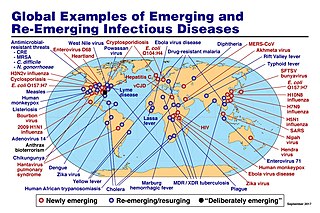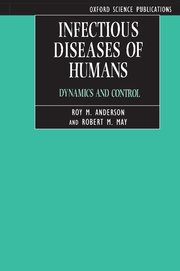Body substance isolation is a practice of isolating all body substances of individuals undergoing medical treatment, particularly emergency medical treatment of those who might be infected with illnesses such as HIV, or hepatitis so as to reduce as much as possible the chances of transmitting these illnesses. BSI is similar in nature to universal precautions, but goes further in isolating workers from pathogens, including substances now known to carry HIV.

Human metapneumovirus (HMPV) is a negative-sense single-stranded RNA virus of the family Pneumoviridae and is closely related to the Avian metapneumovirus (AMPV) subgroup C. It was isolated for the first time in 2001 in the Netherlands by using the RAP-PCR technique for identification of unknown viruses growing in cultured cells. It is the second most common cause after Respiratory syncytial virus (RSV) of lower respiratory infection in young children.

In a physical examination, medical examination, or clinical examination, a medical practitioner examines a patient for any possible medical signs or symptoms of a medical condition. It generally consists of a series of questions about the patient's medical history followed by an examination based on the reported symptoms. Together, the medical history and the physical examination help to determine a diagnosis and devise the treatment plan. This data then becomes part of the medical record.
Hypereosinophilic syndrome is a disease characterized by a persistently elevated eosinophil count in the blood for at least six months without any recognizable cause, with involvement of either the heart, nervous system, or bone marrow.

The Women's Health Initiative (WHI) was initiated by the U.S. National Institutes of Health (NIH) in 1991. The Women's Health Initiative, which consisted of three clinical trials (CT) and an observational study (OS), was conducted to address major health issues causing morbidity and mortality in postmenopausal women. In particular, randomized controlled trials were designed and funded that addressed cardiovascular disease, cancer, and osteoporosis. In its entirety, the WHI enrolled more than 160,000 postmenopausal women aged 50–79 years over 15 years, making it one of the largest U.S. prevention studies of its kind, with a budget of $625 million. A 2014 analysis calculated a net economic return on investment of $37.1 billion for the estrogen-plus-progestin arm of the study's hormone trial alone, providing a strong case for the continued use of this variety of large, publicly funded population study.

Penicillamine, sold under the trade names of Cuprimine among others, is a medication primarily used for the treatment of Wilson's disease. It is also used for people with kidney stones who have high urine cystine levels, rheumatoid arthritis, and various heavy metal poisonings. It is taken by mouth.

An emerging infectious disease (EID) is an infectious disease whose incidence has increased recently, and could increase in the near future. Such diseases do not respect national boundaries. The minority that are capable of developing efficient transmission between humans can become major public and global concerns as potential causes of epidemics or pandemics. Their many impacts can be economic and societal, as well as clinical.

Erythema migrans or erythema chronicum migrans is an expanding rash often seen in the early stage of Lyme disease, and can also be caused by southern tick-associated rash illness (STARI). It can appear anywhere from one day to one month after a tick bite. This rash does not represent an allergic reaction to the bite, but rather an actual skin infection of one of the Lyme bacteria species from the genus Borrelia. The rash's name comes from New Latin for "migrating redness".
Sir Roy Malcolm Anderson is a leading international authority on the epidemiology and control of infectious diseases. He is the author, with Robert May, of the most highly cited book in this field, entitled Infectious Diseases of Humans: Dynamics and Control. His early work was on the population ecology of infectious agents before focusing on the epidemiology and control of human infections. His published research includes studies of the major viral, bacterial and parasitic infections of humans, wildlife and livestock. This has included major studies on HIV, SARS, foot and mouth disease, bovine tuberculosis, bovine spongiform encephalopathy, influenza A, antibiotic resistant bacteria, the neglected tropical diseases and most recently Covid-19. Anderson is the author of over 650 peer-reviewed scientific articles with an h citation index of 125.
Brainerd diarrhea is a sudden-onset watery, explosive diarrhea that lasts for months and does not respond to antibiotics; the cause of Brainerd diarrhea is unknown. Brainerd diarrhea was first described in Brainerd, Minnesota in 1983. It has been associated with the consumption of raw milk and untreated water. Of the ten outbreaks reported since 1983, nine have been in the U.S. The characteristics of each outbreak have been similar to that caused by an infectious agent. Although a comparatively large outbreak occurred in 1996 in Fannin County, Texas., the largest outbreak was the original one in Brainerd, MN. There have been no secondary cases reported in any of the outbreaks, suggesting that the causative agent cannot be passed from person to person, but boiling water appears to inactivate the Brainerd agent. Although there is no treatment available, the disease does appear to resolve itself, although this process takes months if not years.
In biostatistics, spectrum bias refers to the phenomenon that the performance of a diagnostic test may vary in different clinical settings because each setting has a different mix of patients. Because the performance may be dependent on the mix of patients, performance at one clinic may not be predictive of performance at another clinic. These differences are interpreted as a kind of bias. Mathematically, the spectrum bias is a sampling bias and not a traditional statistical bias; this has led some authors to refer to the phenomenon as spectrum effects, whilst others maintain it is a bias if the true performance of the test differs from that which is 'expected'. Usually the performance of a diagnostic test is measured in terms of its sensitivity and specificity and it is changes in these that are considered when referring to spectrum bias. However, other performance measures such as the likelihood ratios may also be affected by spectrum bias.
A clinical prediction rule or clinical probability assessment is a type of algorithm to that includes a combination of medical sign, symptoms, and other findings in predicting the probability of a specific disease or outcome.
Didier Pittet is an infectious diseases expert and the director of the Infection Control Programme and WHO Collaborating Centre on Patient Safety, University Hospital of Geneva, Geneva, Switzerland. Since 2005, Pittet is also the External Lead of the World Health Organization (WHO) Global Patient Safety Challenge "Clean Care is Safer Care" and African Partnerships for Patient Safety.
Campylobacter lari is a species of nalidixic acid-resistant, thermophilic, microaerophilic bacteria first isolated from human faeces. It shows anaerobic growth in the presence of trimethylamine N-oxide hydrochloride. Its type strain is NCTC 11352. It is commonly found in sea gulls. In humans, it has been involved in cases of enteritis, severe abdominal pain and terminal bacteremia.

Stuart Blank Levy was a researcher and physician at Tufts University. He was among the first to advocate for greater awareness of antibiotic resistance and founded the Alliance for the Prudent Use of Antibiotics.
A rectovaginal examination is a type of gynecological examination used to supplement a pelvic examination. In the rectovaginal examination, a doctor or other health care provider places one finger in the vagina and another in the rectum to assess the rectovaginal septum. The examiner will look for any scarring or masses that may indicate cancer or another disease. Typically, a rectovaginal examination is performed to assess pelvic pain, rectal symptoms, or a pelvic mass. It can also provide a sample for fecal occult blood testing.

Charles Stone Bryan is an American retired infectious disease physician, researcher, author and Heyward Gibbes distinguished professor emeritus of internal medicine at the University of South Carolina School of Medicine (UofSC). His contributions to medicine have included working on a formula for administering the maximum possible dose of penicillin to people with kidney failure which would treat the infection and avoid penicillin toxicity, and treating and writing on HIV/AIDS. He is also a noted medical historian and an authority on the life of William Osler.
Bill Stone is a nephrologist at Vanderbilt University Medical Center, who with infectious disease specialist Charles S. Bryan in the 1970s, worked out how to administer the correct doses of penicillin to people with kidney failure, who otherwise might develop toxic levels of penicillin in their blood.

Arnold S. Monto is an American physician and epidemiologist. At the University of Michigan School of Public Health, Monto is the Thomas Francis Collegiate Professor of Public Health, professor of epidemiology, and professor of global public health. His epidemiologic focus is on occurrence, prevention, and treatment of acute infections in the individual and the community.

David "Davey" M. Smith, is an American translational research virologist, Chief of the Division of Infectious Diseases and Global Public Health at the University of California San Diego, Co-Director of the San Diego Center for AIDS Research, and Vice Chair of Faculty in the Department of Medicine at UC San Diego. His research interests include transmission, prevention, and treatment of both HIV and SARS-CoV2 (COVID-19). Since joining the UC San Diego faculty in 2003, Smith has been awarded more than $37 million in federal funding as a Principal Investigator. His research interests include transmission, prevention, and treatment of both HIV and SARS-CoV2 (COVID-19).










